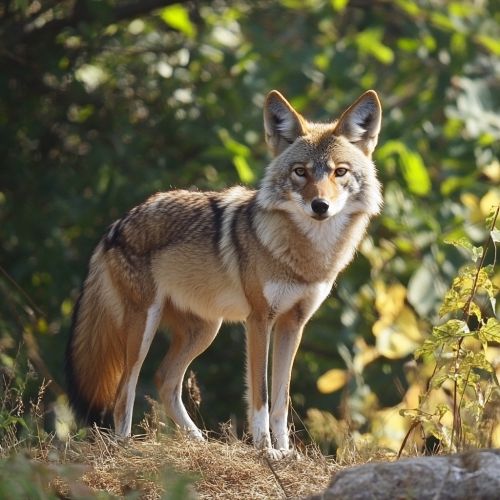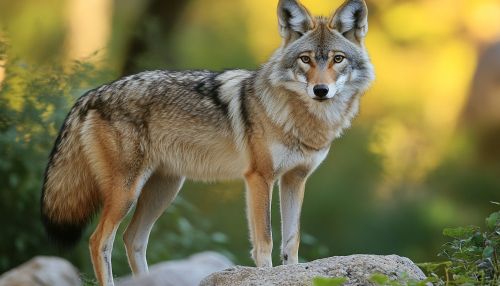Canis latrans: Difference between revisions
No edit summary |
No edit summary |
||
| Line 2: | Line 2: | ||
The '''Canis latrans''', commonly known as the coyote, is a species of canine native to North America. It is smaller than its close relative, the [[Gray Wolf|gray wolf]], and slightly smaller than the closely related eastern wolf and red wolf. The coyote is highly adaptable and can be found in a variety of habitats, including urban areas. This article delves deeply into the biology, behavior, ecology, and interactions of Canis latrans. | The '''Canis latrans''', commonly known as the coyote, is a species of canine native to North America. It is smaller than its close relative, the [[Gray Wolf|gray wolf]], and slightly smaller than the closely related eastern wolf and red wolf. The coyote is highly adaptable and can be found in a variety of habitats, including urban areas. This article delves deeply into the biology, behavior, ecology, and interactions of Canis latrans. | ||
[[Image:Detail-98073.jpg|thumb|center|A coyote standing in a natural environment, looking alert.]] | [[Image:Detail-98073.jpg|thumb|center|A coyote standing in a natural environment, looking alert.|class=only_on_mobile]] | ||
[[Image:Detail-98074.jpg|thumb|center|A coyote standing in a natural environment, looking alert.|class=only_on_desktop]] | |||
== Taxonomy and Evolution == | == Taxonomy and Evolution == | ||
Latest revision as of 16:50, 22 September 2024
Introduction
The Canis latrans, commonly known as the coyote, is a species of canine native to North America. It is smaller than its close relative, the gray wolf, and slightly smaller than the closely related eastern wolf and red wolf. The coyote is highly adaptable and can be found in a variety of habitats, including urban areas. This article delves deeply into the biology, behavior, ecology, and interactions of Canis latrans.


Taxonomy and Evolution
Classification
The coyote belongs to the family Canidae, which includes dogs, wolves, foxes, and other extant and extinct species. The scientific classification of the coyote is as follows:
- Kingdom: Animalia
- Phylum: Chordata
- Class: Mammalia
- Order: Carnivora
- Family: Canidae
- Genus: Canis
- Species: C. latrans
Evolutionary History
The coyote is believed to have diverged from other members of the genus Canis around 1 million years ago during the Pleistocene epoch. Fossil records indicate that the coyote's ancestors were larger and more robust, adapting over time to various environmental changes. The modern coyote is a product of evolutionary pressures that favored smaller, more adaptable canids capable of surviving in diverse habitats.
Physical Characteristics
Morphology
Coyotes are medium-sized canids, with males typically larger than females. They have a slender build, with a bushy tail and pointed ears. The average weight ranges from 7 to 21 kilograms (15 to 46 pounds), and body length varies from 1 to 1.35 meters (3.3 to 4.4 feet), including the tail.
Fur and Coloration
The fur of the coyote is generally a mix of gray, brown, and black, with a lighter underbelly. Seasonal variations occur, with thicker, darker coats in the winter and lighter, shorter fur in the summer. This coloration provides effective camouflage in their natural habitats, which range from forests to deserts.
Behavior and Social Structure
Territoriality
Coyotes are highly territorial animals. They mark their territory with urine and feces and use vocalizations such as howls, yips, and barks to communicate with other coyotes. Territorial boundaries are respected among neighboring packs, although disputes can occur.
Social Organization
Coyotes exhibit flexible social structures. They can live in family units consisting of a mated pair and their offspring, or in larger packs. Solitary individuals are also common, especially among younger coyotes seeking to establish their own territories.
Vocalizations
Coyotes are known for their distinctive vocalizations, which serve various purposes such as marking territory, coordinating pack activities, and social bonding. Their vocal repertoire includes howls, yips, barks, and growls, each with specific meanings and contexts.
Diet and Hunting
Omnivorous Diet
Coyotes are opportunistic feeders with an omnivorous diet. They primarily consume small mammals such as rabbits, rodents, and birds, but their diet also includes fruits, vegetables, insects, and carrion. This dietary flexibility allows them to thrive in diverse environments.
Hunting Techniques
Coyotes employ various hunting techniques depending on the prey. They may hunt alone or in pairs when targeting small mammals, using stealth and speed to capture their prey. For larger prey, such as deer, they may hunt in coordinated packs to increase their chances of success.
Habitat and Distribution
Geographic Range
Coyotes are native to North America and are found from Alaska and Canada in the north to Central America in the south. Their range has expanded significantly due to their adaptability and the decline of larger predators such as wolves and cougars.
Habitat Preferences
Coyotes are highly adaptable and can inhabit a wide range of environments, including forests, grasslands, deserts, and urban areas. They are particularly successful in suburban and urban settings, where they exploit human-related food sources and shelter.
Reproduction and Lifespan
Mating and Breeding
Coyotes typically mate for life, with breeding occurring once a year, usually between January and March. After a gestation period of about 63 days, the female gives birth to a litter of 4 to 7 pups. Both parents participate in raising the young, providing food and protection.
Development of Pups
Coyote pups are born blind and helpless, relying entirely on their parents for nourishment and care. They begin to explore outside the den at about three weeks of age and are weaned by six to eight weeks. By six months, they are capable of hunting small prey and may disperse to establish their own territories.
Lifespan
In the wild, coyotes typically live for 6 to 8 years, although some individuals may reach up to 14 years. In captivity, they can live up to 20 years. Mortality factors include predation, disease, and human-related causes such as vehicle collisions and hunting.
Ecological Role
Predator-Prey Dynamics
Coyotes play a crucial role in maintaining the balance of ecosystems by controlling populations of small mammals and other prey species. Their presence can influence the behavior and distribution of other predators and prey, contributing to the overall health and stability of their habitats.
Interactions with Other Species
Coyotes interact with a variety of other species, both as predators and competitors. They may compete with foxes, bobcats, and domestic dogs for food resources. In some areas, they have been known to hybridize with domestic dogs, resulting in coydogs.
Human-Coyote Interactions
Conflict and Coexistence
Human-coyote interactions are complex and multifaceted. While coyotes are often viewed as pests due to their predation on livestock and pets, they also provide ecological benefits by controlling rodent populations. Efforts to manage coyote populations include lethal control measures, relocation, and public education on coexistence strategies.
Cultural Significance
Coyotes hold significant cultural importance in various Native American traditions and folklore, often depicted as cunning and adaptable tricksters. They are also featured in modern media and literature, symbolizing resilience and adaptability.
Conservation Status
Population Trends
Coyotes are currently classified as a species of least concern by the International Union for Conservation of Nature (IUCN). Their populations are stable and even increasing in many areas, largely due to their adaptability and the decline of larger predators.
Conservation Efforts
Conservation efforts for coyotes focus on promoting coexistence with humans and mitigating conflicts. Research on coyote behavior, ecology, and population dynamics informs management strategies aimed at balancing the needs of both coyotes and human communities.
